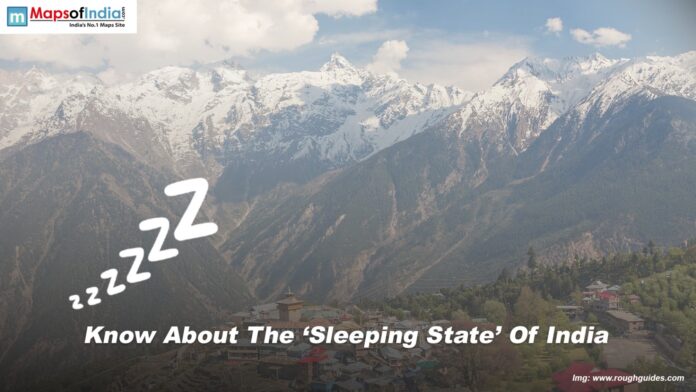India, a huge, diverse nation, has many hidden wonders and fascinating mysteries. It has numerous states, and one of them has the interesting title of “Sleeping State of India.” This term can describe not an official designation but rather an informal reference to a state that is still underdeveloped, less industrialised, and comparatively inactive relative to other rapidly progressing regions. This piece explores the reasons behind this designation, including economic stagnation, infrastructural hurdles, social and cultural factors, and future growth potential.
However, some states, despite their wealth in terms of resources, culture, and history, cannot keep pace with this dynamic nation’s metropolitan explosion. The combination of unhurried industrialisation, the deficit in proper infrastructure, and poor government legislation has ensured these states’ economic slumber. However, these regions have a lot to offer, and they can be turned into flourishing places of expansion with sufficient efforts.
Identifying the ‘Sleeping State’
The reference to some states as “sleeping” in different decades has been different. Still, Bihar, Odisha, and even parts of the North-Eastern region are among the states that get covered in such Jovian forums, primarily due to their slow rate of economic progress compared to the industrialised states of Maharashtra, Karnataka, or Gujarat. For instance, Bihar has been dubbed a ‘sleeping giant’ at various historical points, owing to its vast potential juxtaposed against its slow growth trajectory.
Reasons for Economic and Industrial Stagnation
The slower-than-expected economic and industrial growth in some states of India can be attributed to several reasons:
Historical Challenges
Many of these states have histories of colonial exploitation, post-independence neglect and political instability.
The policies of the British Raj left behind weak infrastructure that continued to impede growth even after the country became independent.
Poor Infrastructure
Underdeveloped roads, highways, railways, and the absence of ports dissuade investment and industrial development.
Electricity supply is inadequate, and power cuts make it challenging for industries to prosper.
Agricultural Dependence
States such as Bihar and Odisha heavily depend on agriculture, with negligible industrial diversification.
Being dependent on monsoons and following traditional farming methods makes agriculture susceptible to seasonal changes affecting the economy.
Limited Industrialisation
Unlike Maharashtra or Tamil Nadu, which are home to large manufacturing hubs, many states lack significant industries or a business-friendly environment.
The lack of large-scale industries and IT hubs means limited employment opportunities.
Poor Quality Education and Unemployment
In certain countries, the literacy rate is lower than the national average, which complements the quality of the workforce.
Insufficient technical and vocational education fails to equip youth with the skills needed in modern industries.
Brain Drain
Many talented students and professionals migrate to metro cities like Delhi, Mumbai, and Bengaluru or abroad for better education and job opportunities.
This leaves no human resources available in the market, which are essential to local growth.
Political and Bureaucratic Challenges
Frequent political instability and corruption discourage start-up businesses.
Cumbersome government processes create an obstacle to obtaining permits and approvals for entrepreneurs.
Social and Cultural Aspects
Yet, even as economic stagnation has padded the wrinkles on its brow, the ‘Sleeping State’ has a long-standing cultural legacy and exhilarating rituals that are still a matter of pride.
Cultural Heritage
Historical states such as Bihar and Odisha house heritage sites such as Nalanda University, Bodh Gaya, Konark Sun Temple, and Jagannath Puri.
These areas’ local folk traditions, festivals, and classical dance forms further enhance their individuality.
Tourism Potential
Pilgrimage tourism is prevalent, and religious sites (Bodh Gaya, Puri, Kamakhya Temple) attract pilgrims, yet the tourism subsector is underdeveloped and lacks infrastructure.
The North-East and the coast of Odisha offer untapped eco-tourism opportunities.
Lifestyle and Rural India
Outsiders settle for metropolitan cities, while many areas follow a traditional lifestyle.
The dominant way of life is agriculture-based, but living in joint family structures is still prevalent.
Potential for Growth and Awakening
The so-called countries are “Sleeping States,” but all these areas can undergo fundamental, if not global, changes. A few actions can spur their growth.
Investment in Infrastructure
While building highways, railways, and industrial corridors would prove useful, it is also important to find facilities that industries or businesses can access.
It will help to promote development through smart cities and digital connectivity initiatives.
Boosting Industrialisation
Creating special economic zones (SEZs) and developing sectors like textile, tourism, and Information Technology can create jobs.
MSMEs (Micro, Small & Medium Enterprises) can help build local economies.
Agricultural Modernisation
Implementing improved irrigation, mechanisation, and sustainable methods will further increase productivity.
Farmers can get better prices through government initiatives such as eNAM (National Agriculture Market) possum.
Educational Reforms
Taking it on getting booked in courses that strengthen skills from a degree in business to professional education.
One can incentivise public-private educational partnerships, which have been shown to lead to higher quality and greater accessibility.
Entrepreneurship and Start-ups
The government and private sector can promote start-up ecosystems to encourage local businesses government and private sector can promote start-up ecosystems to encourage local businesses.
Easier access to loans and less red tape will allow new businesses to thrive.
Tourism Development
By upgrading infrastructure and marketing, cultural and eco-tourism can be promoted and attract national spending and foreign tourism.
Enhancing safety, transfer, and hospitality to make these territories more tourist-friendly would help boost tourism in the regions.
Government Initiatives for Transformation
The Indian government has launched several programs to incentivise the development of lagging states:
- Development of Road Connectivity through Bharatmala and port connectivity through Sagarmala projects
- Mission for Smart Cities Urban Transformation
- Start-Up India & Stand-Up India
- PM Gati Shakti National Master Plan for seamless multi-modal transport
- Commerce and Industry PM KUSUM for enhancing farmers’ income
Conclusion
India’s ‘Sleeping State’ has so much potential yet to be awakened. And though historical and infrastructural challenges have made change slow-moving, targeted investments, policy reform and local participation can deliver transformational impact- as we have shown here in a report on how to provide water access for the billions on the planet without it. However, while still catching up, these states have the right potential to develop into economic engines and sustainably embrace development across different sectors. Suppose they concentrate on industrialisation itself, along with field experts and education. In that case, they can later arise, become as advanced as initial regions, and significantly contribute to India’s GDP and overall rise.




